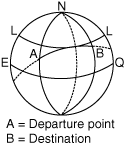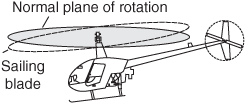- sailing
- i. The method of calculating tracks and distances without plotting and measuring or using other allied processes, such as fixing a position by knowing the run along a track from a starting point. The various types of sailings are parallel sailing, in which the starting and destination points are on the same latitudes; plain, or middle latitude, sailing, which is sailing along a rhumb line from one position to another not situated on the same latitude; great-circle sailing, in which an aircraft follows a great-circle track; and Mercatorial sailing, a method used to find the rhumb-line course and distance between two positions whose latitudes and longitudes are known.
 An example of great circle sailing.ii. The undesired flapping of helicopter rotors at low-rotor RPM, especially during start-up and shutdown and in high-wind conditions is called blade sailing. High winds and gusts will cause the main rotor blades of helicopters to flap up and down and be both a danger to people near them and the helicopter itself, as the blade stops could be damaged, or a particularly flexible blade could hit the tail boom. At certain critical speeds (50–100 RPM), blades will pass in and out of the stall. Holding the cyclic in the direction of the wind will keep the pitch of the advancing blade to a minimum and stop it lifting in the first place. Other ways of minimizing the effect include using rotor brakes (if available) or increasing the RPM rapidly on start-up, switching off the helicopter when it is facing into the wind, especially in high-wind conditions, parking the helicopter away from the downwind side of obstructions or the downwash or slipstream of other machines, keeping the collective down, or accelerating and decelerating the blades as quickly as possible. In addition, pointing the nose out of wind ensures that the lowest deflection is away from the tail boom.
An example of great circle sailing.ii. The undesired flapping of helicopter rotors at low-rotor RPM, especially during start-up and shutdown and in high-wind conditions is called blade sailing. High winds and gusts will cause the main rotor blades of helicopters to flap up and down and be both a danger to people near them and the helicopter itself, as the blade stops could be damaged, or a particularly flexible blade could hit the tail boom. At certain critical speeds (50–100 RPM), blades will pass in and out of the stall. Holding the cyclic in the direction of the wind will keep the pitch of the advancing blade to a minimum and stop it lifting in the first place. Other ways of minimizing the effect include using rotor brakes (if available) or increasing the RPM rapidly on start-up, switching off the helicopter when it is facing into the wind, especially in high-wind conditions, parking the helicopter away from the downwind side of obstructions or the downwash or slipstream of other machines, keeping the collective down, or accelerating and decelerating the blades as quickly as possible. In addition, pointing the nose out of wind ensures that the lowest deflection is away from the tail boom. iii. The art of navigating a seaplane on water.
iii. The art of navigating a seaplane on water.
Aviation dictionary. 2014.
